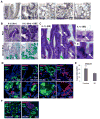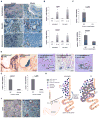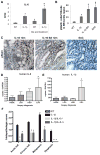Bile acid and inflammation activate gastric cardia stem cells in a mouse model of Barrett-like metaplasia
- PMID: 22264787
- PMCID: PMC3266546
- DOI: 10.1016/j.ccr.2011.12.004
Bile acid and inflammation activate gastric cardia stem cells in a mouse model of Barrett-like metaplasia
Abstract
Esophageal adenocarcinoma (EAC) arises from Barrett esophagus (BE), intestinal-like columnar metaplasia linked to reflux esophagitis. In a transgenic mouse model of BE, esophageal overexpression of interleukin-1β phenocopies human pathology with evolution of esophagitis, Barrett-like metaplasia and EAC. Histopathology and gene signatures closely resembled human BE, with upregulation of TFF2, Bmp4, Cdx2, Notch1, and IL-6. The development of BE and EAC was accelerated by exposure to bile acids and/or nitrosamines, and inhibited by IL-6 deficiency. Lgr5(+) gastric cardia stem cells present in BE were able to lineage trace the early BE lesion. Our data suggest that BE and EAC arise from gastric progenitors due to a tumor-promoting IL-1β-IL-6 signaling cascade and Dll1-dependent Notch signaling.
Copyright © 2012 Elsevier Inc. All rights reserved.
Figures








References
-
- Barbera M, Fitzgerald RC. Cellular origin of Barrett’s metaplasia and oesophageal stem cells. Biochem Soc Trans. 2010;38:370–373. - PubMed
-
- Barker N, Huch M, Kujala P, van de Wetering M, Snippert HJ, van Es JH, Sato T, Stange DE, Begthel H, van den Born M, et al. Lgr5(+ve) stem cells drive self-renewal in the stomach and build long-lived gastric units in vitro. Cell Stem Cell. 2010;6:25–36. - PubMed
-
- Benedito R, Roca C, Sorensen I, Adams S, Gossler A, Fruttiger M, Adams RH. The notch ligands Dll4 and Jagged1 have opposing effects on angiogenesis. Cell. 2009;137:1124–1135. - PubMed
-
- Bernstein H, Bernstein C, Payne CM, Dvorakova K, Garewal H. Bile acids as carcinogens in human gastrointestinal cancers. Mutat Res. 2005;589:47–65. - PubMed
Publication types
MeSH terms
Substances
Associated data
- Actions
Grants and funding
- R01DK060758/DK/NIDDK NIH HHS/United States
- U54 CA126513/CA/NCI NIH HHS/United States
- P30 DK050306/DK/NIDDK NIH HHS/United States
- P01-CA098101/CA/NCI NIH HHS/United States
- U01 CA143056/CA/NCI NIH HHS/United States
- R01 CA120979/CA/NCI NIH HHS/United States
- P30-DK050306/DK/NIDDK NIH HHS/United States
- K07 CA132892/CA/NCI NIH HHS/United States
- R01 CA136673/CA/NCI NIH HHS/United States
- U54 CA163004/CA/NCI NIH HHS/United States
- T35 HL007616/HL/NHLBI NIH HHS/United States
- R01CA120979/CA/NCI NIH HHS/United States
- R01 DK060758/DK/NIDDK NIH HHS/United States
- 5U01 CA143056/CA/NCI NIH HHS/United States
- 1U54CA126513,/CA/NCI NIH HHS/United States
- P01 CA098101/CA/NCI NIH HHS/United States
LinkOut - more resources
Full Text Sources
Other Literature Sources
Medical
Molecular Biology Databases
Research Materials

